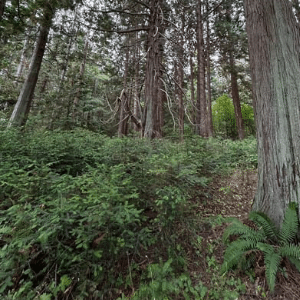The Southern Gulf Islands are an ecological jewel in the heart of the Salish Sea. Unfortunately, on a few of the islands invasive fallow deer are having a devastating impact on the natural ecosystems.
In the first few years of the 20th century the local hunting club introduced European fallow deer to James Island. The deer were successfully introduced to Sidney Island in the 1960’s. On Mayne Island, the fallow deer were released into the environment following a provincially permitted attempt to farm them.
The impact that this invasive species has had on the natural ecosystems of the island environments is astonishing.

Result of browsing by fallow deer on Sidney Island (L) and the forest on Portland Island (R).
Fallow deer have been relentlessly hunted for sport for centuries. They are more skittish and communal than Indigenous black-tailed deer.
Released into forests where they don’t belong; they have terrorized nature. European fallow deer eat everything, starting with the tastiest plant species early in the season and progressing to less appealing species later in the year as food options dwindle.
To the untrained eye, the forests on Sidney and Mayne appear healthy. Mature second growth forest canopy with Douglas fir, maple, cedar and arbutus dominate the landscape. Even though it is drought-stressed, it looks okay. It’s the lack of understory that is concerning. The near complete absence of the teenage generation of all those critical tree species indicates a forest with no future. The lack of berries, ocean spray, and many other shrub species that provide essential habitat for countless bird and animal species is also cause for urgent concern. The absence of these native plants and animals makes the forest susceptible to invasive species such as scotch broom and English Hawthorn.
Recently, my relatives went to Mayne to harvest medicines, primarily nettle, and it is entirely gone from a landscape that once produced a near endless supply.
On Portland Island where there are no fallow deer, there is a rich understory of shrub species and adolescent trees that will ensure the continuation of a rich and healthy forest ecosystem.

Forest on Portland Island with no fallow deer.
Comparing the desolate forests on Sidney and Mayne to the rich ecosystems on Portland Island, it is clear that the fallow deer have upset the balance on the Islands they inhabit.
Human intervention introduced fallow deer to the islands, human intervention is needed to restore ecological equilibrium.
With no natural predators on the Gulf Islands the fallow deer dominate their ecosystem, and they are modifying the landscapes, relentlessly consuming indigenous plant species that are critical foods, medicines, and for ceremonial purposes.
There is yet another concern, one that poses a more immediate threat to the human population on the islands — wildfire. Ensuring forests are as resistant to fire as possible is essential. On Sidney, one tree species that is doing well is Grand Fir. Apparently, the natural oils in Grand Fir taste worse than fallow deer are hungry, so you can see clusters of young Grand Fir growing robustly in the understory. However, these natural oils also make Grand Fir significantly more susceptible to fire than other tree species.

Grand fir establishing dominance on Sidney Island
Grand fir is not the species we need dominating the forests, on remote drought prone islands.
Fallow deer do not belong here. It’s not their fault that for centuries they have been shipped around the world and introduced into environments to be hunted for sport.
Parks Canada is working with the W̱SÁNEĆ people through the W̱SÁNEĆ Leadership Council, and others, to develop a program to remove the species from Sidney Island and restore the forest. I have been advocating to the provincial government to step up and coordinate a plan to address the fallow deer population on Mayne.
I am pleased that we have made positive progress with Minister Nathan Cullen (Ministry of Water, Land, Resource Stewardship) who has been mandated by Premier David Eby to lead the effort to protect and enhance biodiversity.
There is an opportunity for the province to learn from Parks Canada’s approach and develop a comprehensive plan for Mayne that identifies and accommodates the island’s unique differences.

Fenced off area on Sidney Island.
As the MLA for the Southern Gulf Islands, I have looked into this issue extensively over the past six years. I have heard from constituents concerned about the fallow deer and from the advocates protecting the fallow deer. I have heard the concerns raised by animal rights advocates and constituents about the program that will begin this Fall on Sidney Island. I appreciate the challenges that we face by acting to remove this introduced invasive species, as well as the impact of doing nothing. Fallow deer are a problem that cannot be ignored any longer.
It’s necessary to restore a resilient biodiverse ecosystem. A small area, fenced off decades ago on Sidney Island, shows what the understory of the islands should look like. There is a remarkably rich environment waiting to emerge. However, it is only possible with the removal of fallow deer on the landscape.


Thank you Adam for your strong advocacy on behalf of the imperiled ecosystems on S’ktak and other islands with fallow deer.